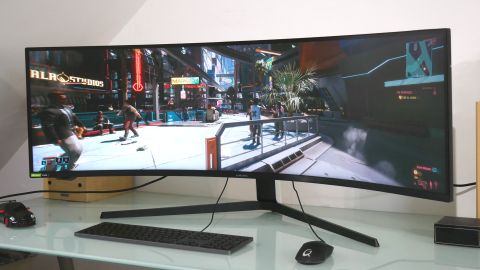Our Verdict
Samsung’s insane 49-inch gaming beast packs an incredible punch, but flawed HDR implementation is disappointing.
For
- Incredibly immersive 49-inch panel
- Fantastic pixel response for a VA panel
- Great all-round feature set
Against
- Only 10 edge-lit local dimming zones
- Form factor can be problematic
- Very pricey
PC Gamer's got your back
Unlike most PC components, monitor tech used to progress gradually. Not any longer. Just a few years ago, it would have been hard to imagine a 49-inch monster like the Samsung Odyssey G9 with its outrageous 1000R curve. In a couple of years’ time? It’ll be totally obsolete.
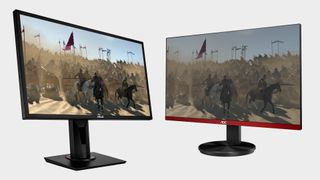
Best gaming monitor: pixel-perfect panels for your PC
Best high refresh rate monitor: screaming quick screens
Best 4K monitor for gaming: when only high-res will do
Best 4K TV for gaming: big-screen 4K PC gaming
We’ll get to the reasons why imminently. But first, let's square away what makes the Samsung Odyssey G9 spectacular in the here and now. Obviously, it all begins with that ridiculous 49-inch panel. The 5,120 by 1,440 native resolution arguably isn’t all that exciting given the size and aspect ratio. Certainly, it makes for an unimpressive pixel density of 109 pixels per inch. A high DPI experience this ain’t.
Instead, it’s the sheer scale and the outrageously tight curvature that separates the G9 from just about every other monitor. The 1000R curve means that if you extended the panel to complete the circle it is partially describing, said circle would be just one metre in radius. Bonkers.
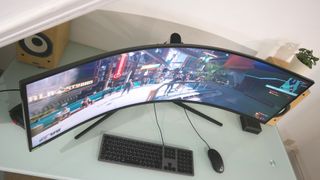
The panel’s other key features include 240Hz refresh, FreeSync and G-Sync support, HDR 1000 certification including a peak brightness of 1,000 nits, 2,500:1 contrast, 95% coverage of the DCI-P3 gamut, and 1ms response. That’s one heck of a list. Then there’s the panel type. Samsung has gone for VA technology, which is usually great for contrast, less so for response.
Anyway, it also doesn’t hurt that the G9 looks like a million bucks from almost any angle. OK, the chassis is plastic. But the glossy white finish looks classy, while the ‘Infinity Core’ LED lighting is slick and funky. The overall effect is something akin to a big-budget sci-fi prop. We like.
Screen size: 49-inch
Panel technology: VA
Native resolution: 5120 x 1440
Aspect ratio: 32:9
Refresh rate: 240 Hz
Response tune: 1ms GtG
HDR: VESA DesplayHDR 1000
Contrast: 2,500:1
Color: 95% DCI-P3
Brightness: 420 nits SDR, 1,000 nits HDR
Connections: HDMI 2.0 x1, DisplayPort 1.4 x2, 3x USB 3.0
Other: G-Sync Compatible, FreeSync Premium, 3x USB 3.0 hub
We also like most aspects of the Odyssey G9’s performance. A lot. First up, let’s attend to any doubts over response due to the VA panel. Samsung has included three user-configurable levels of overdrive in the G9’s OSD menu. Subjectively, they’re difficult to tell apart. But the important conclusion is that the G9 is properly fast and comparable with 1ms IPS monitors. Phew.
There are a few slight snags. Overdrive isn’t available with either adaptive refresh or low input-lag mode. But response still looks good with FreeSync or G-Sync available and there’s no discernible latency whether you enable the low input lag mode or not.
The major issue involves HDR performance. It’s a bit of a mess. For starters, while the G9 does have local dimming, as you’d expect from an HDR1000 panel, it’s limited to just 10 edge-lit zones, which makes it pretty much entirely pointless. In mitigation, the inherent contrast, rated at 2,500 to one, of the VA panel ought to help boost HDR performance. But in practice, HDR content is underwhelming on the G9 and lacks the visual highs you’d normally expect from an HDR1000 panel.
So, this monitor does its best work as a particularly punchy SDR screen, in which mode it’s good for 420 nits. In PC gaming terms, you haven’t lived until you’ve seen CyberPunk 2077 running in all its ray-traced, DLSS’ed glory on the G9. It’s something very special. A lot of that is down to immersion. The outrageous 32:9 aspect, plus the very tight curve and mega 49-inch proportions, make for an incredible wrap-around experience. Just remember that you’ll need one heck of a graphics card to drive this screen smoothly in the latest games. The overall pixel count is nearly as high as full 4K.
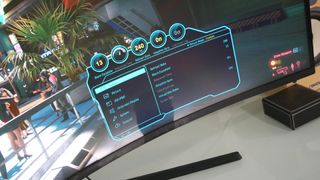
Of course, the extreme aspect isn’t a winner in all game types. The wider available field of view is inevitably deemed an unfair advantage in online shooters including Call of Duty: Warzone and battle royale fodder like Fortnite. So, you have to choose between stretching a 16:9 field of view across a 32:9 panel, or running with huge black bars left and right.
More generally, the uber-wide aspect may or may not be a good fit with the UI of any given game, your mileage will vary. Similarly, it’s not much good if you share your monitor with a games console. And from a productivity perspective, the mediocre pixel pitch and shallow panel height limit the G9’s appeal. At this price point, there are far better options for getting work done.
Oh, and that obsolescence we mentioned? Samsung is already plotting a follow-up to the G9. It will have a mini-LED backlight with dramatically more dimming zones, probably two thousand or more. It may be even more expensive. But then if you can afford this G9, you can probably afford whatever comes next. With that in mind, as impressive as the G9 is in many regards, in this specification with the flawed HDR implementation it feels like a stepping stone, a beta version of what will likely become an absolutely stellar monitor with an upgrade to mini-LED tech.
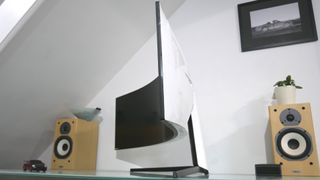
It’s also worth noting that Samsung offers the CRG90 with a similar 49-inch feature set, but gentler of curve and only humming along at 120Hz, for a lot less cash. All of which means the G9 is an incredible screen. But it’s tough to unreservedly recommend.
Samsung’s insane 49-inch gaming beast packs an incredible punch, but flawed HDR implementation is disappointing.

Jeremy has been writing about technology and PCs since the 90nm Netburst era (Google it!) and enjoys nothing more than a serious dissertation on the finer points of monitor input lag and overshoot followed by a forensic examination of advanced lithography. Or maybe he just likes machines that go “ping!” He also has a thing for tennis and cars.
